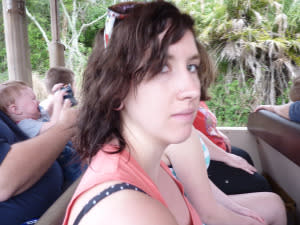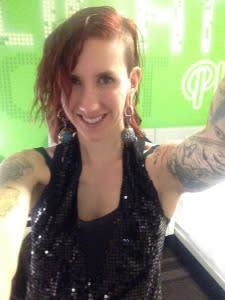Which of These Two Photos Is the ‘Look’ of Depression?
In late 2011, I realized what depression looks like.
While importing photos from a family trip to Disney World, I came across one which showed “the real me” — the person behind the cheesy smile. The one without props or people to hide behind.
This is me in Animal Kingdom. My husband and I were riding Kilimanjaro Safari which, for those unacquainted, is a kitschy, pseudo-safari — half ride, half zoo/nature preserve— through Disney’s version of sub-Saharan Africa. In between photos of antelope and elephants, my husband snapped one of me.
Related: To the Husband With the Wife Who Has Depression

While some may assume this is just a bad angle or an ill-timed shot, it wasn’t. How can I be so sure? Because I remember it. I remember the horrible pizza I ate that morning for breakfast, the ache in my arms and neck from a rough night before and the overwhelming sense of sadness I felt as I sat in that fiberglass seat. I couldn’t muster a smile or any ounce of artificial joy.
Of the hundreds of photos from that trip, this is the one that stood out. Of the thousands of digital memories I have, this is the moment that haunts me.
What gets to me most is the blank, vacant gaze.
I know that face. I’ve met her lifeless form in mirrors, car windows and on glass doors. Once or twice I’ve even caught her hollow glance wrapped around the curved surface of a shiny Christmas ball, warped and red but otherwise the same.
Related: The Most Ridiculous Things People With Invisible Illness Hear
Flash forward four years later and that me is still there (is here); I’ve just learned to carry her better. Some days I am better — thanks to therapy, meditation and my writing — but some days I fake it, hoping my crooked front teeth and slight overbite hide the lump I’m swallowing in my throat.
Now when I step in front of the camera I hear one of two things: “Oh stop. Give me a real smile” or “Perfect. You look so happy!”
Because depression also looks like this.

The face of depression often appears “normal,” because it a) is normal and b) we try to hide it due to embarrassment, shame, secrecy or one of a million other reasons. Commercials for antidepressants would often have you believe that we (the depressed) sit on the floor everyday, our knees hugged to our chest or stare longingly out a window. And while I’ve been known to peek through my blinds instead of opening them, that isn’t how I spend every day.
Related: A Letter to Those Affected By My Anxiety
Because depression, while a chronic disease, isn’t a 24/7 disease — making it that much more insidious. I work. I take care of my 2-year-old daughter. I go out and hang out with my friends. I attend family get-togethers. I have good and bad days, and while some days life seems insurmountable — and I’m short-tempered, snappy and struggling to swallow tears — other days are fine. Other days I play in the park with my daughter, chasing ducks and keeping her from diving into the lake.
Other days I’m what is often perceived as “normal.”
And while I loathe the word normal, I will use it here because depression is a disease, a normal disease. Whatever you look like today — happy, sad, vacant, stressed, angry or excited — you are OK. You are totally normal.
In order stop the stigma surrounding depression and mental illness, Kimberly asks that you take a photo of yourself on social media and tag it #snapshotsforsanity.
By Kimberly Zapata, Sunshine Spoils Milk
More from The Mighty:
12 Things to Know When Someone You Love Has Anxiety
The Powerful Reason People Are Putting Semicolons on Their Skin
She Questioned Our Use of a Handicapped Parking Spot. I Wish I Asked Her This.

